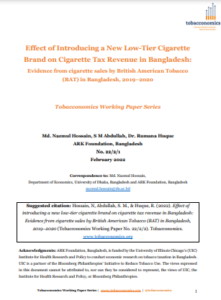
Background
A substantial body of evidence demonstrates that significantly increasing cigarette prices via cigarette tax increases is the most effective way to reduce cigarette smoking in addition to producing higher tax revenue. In Bangladesh, the complicated tiered ad valorem cigarette tax system, with a low base price for each tier, has made tobacco tax a less effective instrument to control smoking while also creating opportunities for cigarette manufacturers to avoid taxes. In addition to these existing challenges, in fiscal year (FY) 2019-20 the Bangladesh government increased the difference between low and medium-tier base prices, making low-tier cigarettes even more affordable. This price change, together with a significantly lower ad valorem excise tax for low-tier cigarettes, created a window for manufacturers to expand the market for low-tier cigarettes, which not only made low-tier cigarettes more accessible to low-income smokers but also resulted in revenue loss for the government. This study attempts to estimate the possible reduction in government tax revenue resulting from British American Tobacco (BAT)’s expansion of the low-tier market and its reduction in supply of medium-tier brands. Additionally, this study analyzes the impacts of cigarette tax policies and makes policy recommendations to prevent cigarette companies’ further attempts to avoid taxes by expanding the low-tier cigarette market.
Methodology
To estimate the loss in tax revenue and to analyze the effect of different tax policies, this study utilizes the WHO Tobacco Tax Simulation Model (TaXSiM), applying brand prices and sales volumes of BAT’s cigarette brands for FY 2019-20 provided by the National Board of Revenue (NBR). First, the baseline tax revenue and industry revenue from BAT’s cigarette brands are estimated. Then different scenarios are designed, comprising different actions from BAT and different tax policies by the government. Using TaXSiM, this study estimates the tax revenue and industry revenue under different simulated scenarios. Comparison of results from different scenarios with the baseline results are made to estimate the tax revenue gap and to estimate the effect of different tax policies on preventing manufacturers from expanding the low-tier market and on increasing tax revenues.
Results
This study estimates that the government revenue gap due to BAT’s introduction of a new low-tier brand in FY 2019-20 is around 2.73 billion to 9.84 billion Bangladeshi taka. This study also finds that increases in cigarette price without a change in excise tax rates would result in a large increase of industry revenue (ranging from 2.13 billion to 7.73 billion taka), which might induce BAT to further expand its low-tier market, which in turn would result in a higher tax revenue gap. Comparing the baseline results with the results of the simulation scenario where the government increases the base price of low-tier cigarettes along with imposing a uniform ad valorem excise tax rate for all tiers, this study finds the estimated revenue gap to be 34.90 billion to 42.01 billion taka. Also, under this scenario BAT’s revenue is estimated to be lower compared to the baseline results. This implies that BAT would be less motivated to introduce a new brand to the low tier with this policy intervention. The game theoretical analysis also confirms that imposing the uniform ad valorem excise tax along with an increase in the base price of low-tier cigarettes would be a dominant strategy for the government, discouraging cigarette manufacturers like BAT from expanding low-tier brands while ensuring significant increases in tax revenue.
Conclusions
There is a high level of commitment from the government to control tobacco use in Bangladesh, and cigarette taxes are a major source of revenue for the Bangladesh government. To control tobacco use and increase cigarette tax revenue, the findings from this study lead the authors to strongly recommend that the Bangladesh government should simplify the cigarette tax structure by imposing a uniform tax for all tiers along with a significant increase in the base price of each tier. Further, this study finds that the least effective policy option is to increase only the base price of cigarettes without increasing the excise tax rates, which would induce cigarette manufacturers to expand the low-tier market and in turn would result in higher tax revenue loss.
To read with source link please click here.
Effect of Introducing a New Low-Tier Cigarette Brand on Cigarette Tax Revenue in Bangladesh
Md. Nazmul Hossain, S M Abdullah, Dr. Rumana Huque

